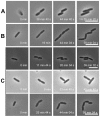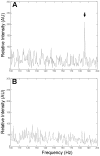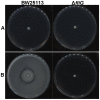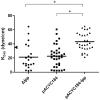Factors affecting daughter cells' arrangement during the early bacterial divisions
- PMID: 20161768
- PMCID: PMC2818839
- DOI: 10.1371/journal.pone.0009147
Factors affecting daughter cells' arrangement during the early bacterial divisions
Abstract
On agar plates, daughter cells of Escherichia coli mutually slide and align side-by-side in parallel during the first round of binary fission. This phenomenon has been previously attributed to an elastic material that restricts apparently separated bacteria from being in string. We hypothesize that the interaction between bacteria and the underneath substratum may affect the arrangement of the daughter bacteria. To test this hypothesis, bacterial division on hyaluronic acid (HA) gel, as an alternative substratum, was examined. Consistent with our proposition, the HA gel differs from agar by suppressing the typical side-by-side alignments to a rare population. Examination of bacterial surface molecules that may contribute to the daughter cells' arrangement yielded an observation that, with disrupted lpp, the E. coli daughter cells increasingly formed non-typical patterns, i.e. neither sliding side-by-side in parallel nor forming elongated strings. Therefore, our results suggest strongly that the early cell patterning is affected by multiple interaction factors. With oscillatory optical tweezers, we further demonstrated that the interaction force decreased in bacteria without Lpp, a result substantiating our notion that the side-by-side sliding phenomenon directly reflects the strength of in-situ interaction between bacteria and substratum.
Conflict of interest statement
Figures







Similar articles
-
Estimation of the adhesive force distribution for the flagellar adhesion of Escherichia coli on a glass surface.Colloids Surf B Biointerfaces. 2015 Jul 1;131:67-72. doi: 10.1016/j.colsurfb.2015.04.038. Epub 2015 Apr 23. Colloids Surf B Biointerfaces. 2015. PMID: 25956746
-
Arrangement of core membrane segments in the MotA/MotB proton-channel complex of Escherichia coli.Biochemistry. 2004 Jan 13;43(1):35-45. doi: 10.1021/bi035406d. Biochemistry. 2004. PMID: 14705929
-
NlpI contributes to Escherichia coli K1 strain RS218 interaction with human brain microvascular endothelial cells.Infect Immun. 2010 Jul;78(7):3090-6. doi: 10.1128/IAI.00034-10. Epub 2010 Apr 26. Infect Immun. 2010. PMID: 20421385 Free PMC article.
-
Role of bacterial cell surface structures in Escherichia coli biofilm formation.Res Microbiol. 2005 Jun-Jul;156(5-6):626-33. doi: 10.1016/j.resmic.2005.02.005. Epub 2005 Mar 22. Res Microbiol. 2005. PMID: 15950122 Review.
-
Regulation of interaction between signaling protein CheY and flagellar motor during bacterial chemotaxis.Curr Top Cell Regul. 1996;34:137-58. doi: 10.1016/s0070-2137(96)80005-7. Curr Top Cell Regul. 1996. PMID: 8646846 Review. No abstract available.
Cited by
-
Arginine methylation of hnRNPK negatively modulates apoptosis upon DNA damage through local regulation of phosphorylation.Nucleic Acids Res. 2014 Sep;42(15):9908-24. doi: 10.1093/nar/gku705. Epub 2014 Aug 7. Nucleic Acids Res. 2014. PMID: 25104022 Free PMC article.
-
Chirality in microbial biofilms is mediated by close interactions between the cell surface and the substratum.ISME J. 2017 Jul;11(7):1688-1701. doi: 10.1038/ismej.2017.19. Epub 2017 Apr 14. ISME J. 2017. PMID: 28362723 Free PMC article.
-
Bacterial colony from two-dimensional division to three-dimensional development.PLoS One. 2012;7(11):e48098. doi: 10.1371/journal.pone.0048098. Epub 2012 Nov 14. PLoS One. 2012. PMID: 23155376 Free PMC article.
References
-
- Graham-Smith GS. The division and post-fission movements of bacilli when grown on solid media. Parasitology. 1910;3:17–53.
-
- Donachie WD, Begg KJ. Growth of the bacterial cell. Nature. 1970;227:1220–1224. - PubMed
-
- Rosenfeld N, Young JW, Alon U, Swain PS, Elowitz MB. Gene regulation at the single-cell level. Science. 2005;307:1962–1965. - PubMed
-
- Matroule JY, Lam H, Burnette DT, Jacobs-Wagner C. Cytokinesis monitoring during development; rapid pole-to-pole shuttling of a signaling protein by localized kinase and phosphatase in Caulobacter. Cell. 2004;118:579–590. - PubMed
Publication types
MeSH terms
Substances
LinkOut - more resources
Full Text Sources
Research Materials

